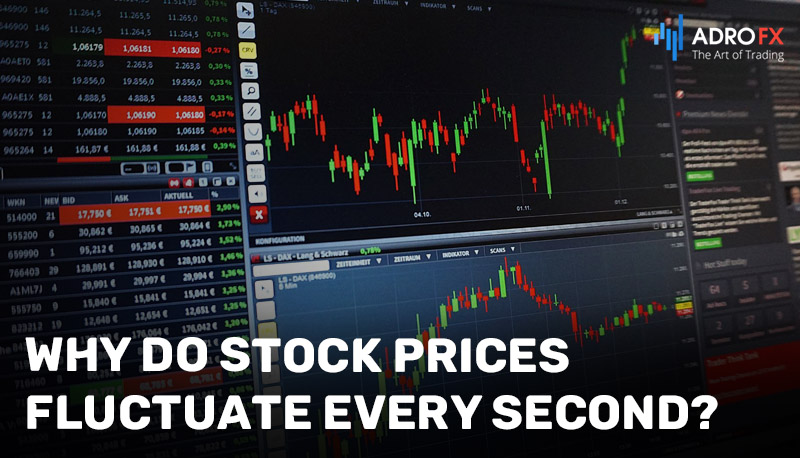How to Understand Stock Prices: Forces, Factors, and Strategies

Stock prices exhibit even greater volatility than the fluctuations in weather patterns.
Each share of stock in a publicly traded company, a company whose stock is traded on major exchanges like the New York Stock Exchange and the Nasdaq market, is associated with a specific price. When an investor acquires a share, they essentially own a piece of that company.
Primarily, the per-share price of a stock is determined by the dynamics of supply and demand. If the demand for a limited number of shares surpasses the available supply, the stock price typically experiences an upward trajectory. Conversely, when the supply exceeds demand, it tends to lead to a decline in the stock price.
Setting the Prices of Stocks
The heartbeat of stock prices is supply and demand. The number of buyers versus sellers dictates a stock's value. If more people desire a stock, its price ascends; conversely, higher supply and lower demand lead to a price decline.
For instance, consider the fervor of investors vying for shares of ABCD Inc., a fictional energy company. One day, these shares may trade at $35 each. But the next day, a bullish report on the energy sector by a Wall Street analyst ignites a surge in demand, propelling ABCD stock to $40 per share, a swift 14% surge in just one day.
On the flip side, let's explore RXYZ Co., an imaginary healthcare firm. On one day, its stock might be valued at $45 per share. However, a bearish report on the healthcare sector by a Wall Street analyst the following day spurs some investors to offload their RXYZ holdings. This triggers a sharp drop in the stock's value, with shares now trading at $40 each, marking an 11% dip in a single day.

What Shapes Stock Prices for Publicly Listed Companies?
Stock prices are not solely dictated by the simple forces of supply and demand; they are subject to a symphony of factors that collaboratively steer them upwards or downwards.
Corporate Activity:
The actions of a company play a pivotal role in influencing its stock price. Positive occurrences, such as strong financial results, can embolden investors, leading to an increase in share purchases and a subsequent rise in the stock's value. Conversely, poor financial performance can shatter confidence, prompting investors to sell their shares.
Additionally, other corporate events that can propel stock prices in either direction include:
- The granting of a patent for a promising new product or service.
- The expansion of the company into international markets.
- Unexpected changes in leadership, such as the sudden departure of a CEO.
- Loss of a significant customer, which can undermine revenue and confidence.
Economic Conditions:
The broader economic landscape also exerts significant influence over stock prices. When economic indicators, like a decrease in the unemployment rate and a surge in job creation, project confidence in the economy's trajectory, investors tend to become more willing to invest in the stock market. This increased demand often leads to higher share prices for specific companies.
Conversely, if job growth figures disappoint and unemployment rates rise, investor unease can trigger a mass exodus from the stock market, resulting in a decline in share prices. In a broader context, stock prices generally ascend during times of economic optimism and descend when signs of a looming recession appear on the horizon.
Inflation:
Inflation, the broad increase in the prices of goods and services, weakens the purchasing power of both businesses and consumers. When inflation rates rise, investors often grow concerned about the state of the economy, leading some to sell their stock holdings. Conversely, a decline in inflation rates tends to foster optimism, encouraging increased stock purchases. In essence, the direction of inflation has a noticeable impact on stock prices.
Moreover, high inflation can undermine a company's financial performance by driving up the costs of procuring goods and services. These increased expenses eat into a company's profitability, rendering its stock less appealing to investors and resulting in price declines.
Interest Rates:
Interest rates play a crucial role in determining borrowing costs for companies. Elevated interest rates can increase corporate borrowing expenses, negatively affecting corporate earnings and causing a general dip in stock prices.
Additionally, higher interest rates can diminish the attractiveness of stocks in comparison to investment alternatives such as certificates of deposit (CDs), bonds, and other vehicles that thrive in higher interest rate environments. As investors shift their focus to these alternatives, stock prices can experience a decline. Conversely, lower interest rates can have the opposite effect, potentially enhancing earnings prospects and raising share prices.
Consumer Spending:
The vitality of consumer spending can significantly impact a wide array of publicly traded companies. It serves as a vital driver of short-term economic growth in the U.S. economy. A robust level of consumer spending can drive sales, earnings, and, consequently, share prices for these companies. Conversely, a decline in consumer spending can hinder corporate sales, earnings, and stock values.
Global Events:
Geopolitical risks, such as wars and acts of terrorism, have the potential to sow instability not only within nations but also within the stock market. Data from LPL Research shows that from 1941 to 2020, the S&P 500 stock index averaged a 5% decline during 20 major geopolitical crises, including events like the attack on Pearl Harbor, the assassination of President John F. Kennedy, and the 9/11 terrorist attacks. However, it's noteworthy that the index typically rebounded within an average of 50 days following such crises.
Moreover, research published by the International Monetary Fund from 1985 to 2020 indicates that geopolitical risks contributed to stock returns declining by a range of 10.53% to 42.14%. These conclusions were drawn from an analysis of stock returns in 22 different countries.
Major Investors:
Actions taken by significant institutional investors, including mutual funds and hedge funds, can also play a substantial role in driving stock price fluctuations. These entities hold substantial volumes of shares, and their buying and selling decisions can exert a notable influence on stock prices.

Why Do Stock Prices Fluctuate Every Second?
Stock prices undergo continuous changes in response to a variety of developments, be it official company announcements, speculation, or government-released economic data. In the past, it would take some time for new information to be reflected in stock prices. However, with the advent of electronic stock trading, transactions can now occur rapidly with a simple click of a button.
When investors receive new information about a company, it can influence their decision to buy or sell its stocks. If more people are inclined to buy the stock, its price will rise. Conversely, if more people are selling the stock, the price tends to fall.
Additionally, information about a company can alter people's perception of owning the company's stock. If the company reports poor earnings, individuals may opt to sell their shares. However, if the company is engaged in exciting new ventures, those who were planning to sell might reconsider and seek to purchase more of its shares.
Staying Informed in the World of Stocks
To navigate the ever-evolving landscape of the stock market effectively, consider these four recommendations:
- Knowledge is Power
Equip yourself with a deep understanding of the stock market. Before investing in stocks, it's crucial to comprehend both the company and the industry it operates in. Moreover, be well-versed in the key factors that sway stock prices. - Stay Informed, Not Obsessive
Staying informed is valuable, but there's no need to obsess over every minute of market movement. Keep yourself updated on your current and potential investments. This entails reading investment statements, tracking market activity online or through apps, examining reports from stock brokerages and research firms, and studying reports issued by publicly traded companies. As an informed investor, monitoring stock values, their 52-week highs and lows can offer insights into a company's historical performance and any emerging trends. - The Virtue of Patience
Wise investors take a long-term perspective when managing their portfolios. In other words, exercise patience and hold onto stocks through both favorable and adverse market conditions. For instance, a $10,000 investment in S&P 500 stocks in 1980 would have grown to $980,911 by 2021 if the investor remained steadfast throughout. However, missing the 10 best trading days during that period would have reduced the portfolio's value by more than half, to $437,902.
Conclusion
In the world of finance, stock prices are akin to the ever-shifting currents of a turbulent sea, exhibiting remarkable volatility. Each stock represents a unique value, and investors enter a dynamic dance of supply and demand. Prices rise with heightened demand and fall when supply outpaces demand, a phenomenon influenced by factors such as corporate decisions, economic conditions, inflation, interest rates, and global events.
Professional guidance and continuous learning are essential tools in this unpredictable landscape. Advisors act as navigational compasses, and informed investors are better equipped to seize opportunities and weather market turbulence. Patience, too, plays a pivotal role, as long-term perspectives often yield favorable outcomes.
In conclusion, comprehending and navigating the intricate world of stock prices is vital. With professional guidance, knowledge, and patience, investors can effectively harness the dynamic nature of stock prices, charting a course toward financial success.
About AdroFx
Established in 2018, AdroFx is known for its high technology and its ability to deliver high-quality brokerage services in more than 200 countries around the world. AdroFx makes every effort to keep its customers satisfied and to meet all the trading needs of any trader. With the five types of trading accounts, we have all it takes to fit any traders` needs and styles. The company provides access to 115+ trading instruments, including currencies, metals, stocks, and cryptocurrencies, which make it possible to make the most out of trading on the financial markets. Considering all the above, AdroFx is the perfect variant for anyone who doesn't settle for less than the best.









